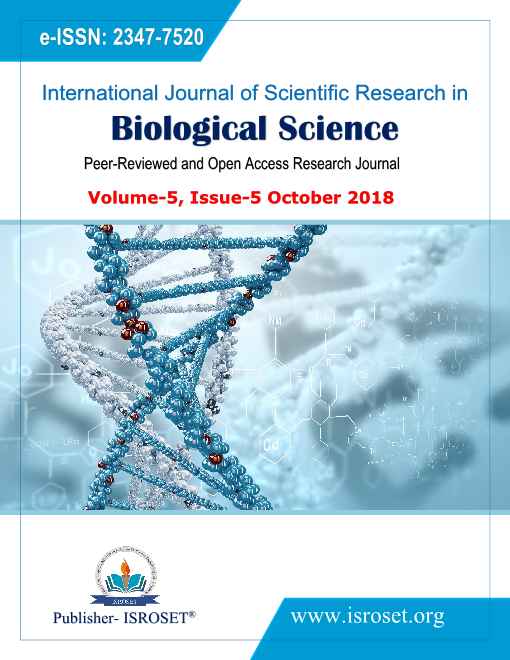Effect of antimicrobial activity of Eupatorium odoratum against clinical microbes
Keywords:
Epotorium odoratum, bacteria, nutrient agarAbstract
Traditional medicine is an important source of potentially useful compounds for the development of phytotherapetic agent. Antimicrobials of plant origin have enormous therapeutic potential in the treatment of infectious diseases while simultaneously migitigiting many of the side effects that are often associated with synthetic antimicrobials. In the present investigation suggested that the effect of antimicrobial activity of Epotorium odoratum against clinical microbes were performed. In the experiments of the test plant with different concentration of 25, 50, 75, and 100µl of aqueous and methanolic leaf extract were treated against the bacteria like Bacillus sp., E.coli, Entrococcus sp., K.pnemoniae and Staph. aureus and fungi such as Aspergillus flavus, A.niger. A.terreus, Penicillium sp. and Trichoderma sp. Performed respectively. However the antimicrobial properties of E.odoratum leaf with methanolic extract of higher concentration was excellent performance when compared to other solvent of aqueous extract of same plant. It can be concluded that the plant can be used to discover natural products that may serve as lead for the development of new biomedical applications.
References
S. Willium, “Biological Sciences”, IEEE Transaction, Vol.31, Issue.4, pp.123-141, 2012.
D. Diallo, B. Hveem, M.A. Mahmoud, G. Betge, B.S. Paulsen, A. Maiga, “An ethnobotanical survey of herbal drugs of Gourma district”. Pharmaceutical Biology; vol. 37 pp. 80-91, 1999.
R.A.A. Mothana, S.A.A. Abdo, S. Hasson, F.M.N. Althawab, S.A.Z. Alaghbari, U. Lindequist, “Antimicrobial, antioxidant and cytotoxic activities and phytochemical screening of some Yemeni medicinal plants”. Evidence-Based Complementary and Alternative Medicine, vol. 7, Issue 3, pp.323–330, 2010
S.J. Leu, Y.P. Lin, R.D. Lin, “Phenolic constituents of Malus doumeri var. formosana in the field of skin care”. Biological and Pharmaceutical Bulletin, vol. 29 Issue 4, pp. 740–745. 2006
M.Yadav, K.K. Khan, “Antimicrobial activity of some ethnomedicinal plants used by tribes of rewa, madhya Pradesh”. Indian J L Sci.; vol 1, Issue 4, pp. 35-38, 2012.
Michael Joyeux, Francois Mortier, Jacques Fleurentin, “Screening of antiradical, antilipoperoxidant and hepatoprotective effects of nine plant extracts used in Caribbean folk medicine”. J of Phytotherapy Research, vol 9 Issues 5, pp. 228-230. 2006
S. Umukoro, R. B. Ashorobi, “Evaluation of Anti-inflammatory and membrane stabilizing effects of Eupatorium odoratum”. Int J of Pharmacol, vol. 2 Issue 5: pp. 509-512. 2006
P. Vadhana, B.R. Singh, M. Bhardwaj, S.V. Singh. “Emergence of herbal antimicrobial drug resistance in clinical bacterial isolates”. Pharm Anal Acta, vol. 6 Issue 3, ..p 434-439, 2015
H.R. El-Seedi, T. Ohara, N. Sata, S. Nishiyama, “Antimicrobial diterpenoids from Eupatorium glutinosum (Asteraceae)”. J Ethnopharmacol, vol. 81 Issue 2, pp. 293.
S. Patel, N. Venugopalan, S. Pradeep, “Screening for antimicrobial activity of weeds”. The Internet J Microbiol. Vol 4 Issue 1, pp. 26- 98. 2006
J.S.Britto, “Comparative antibacterial activity study of Solanum Incanum L”. J Swamy Botanical Club, vol. 18 Issue 5, pp. 81-82. 2001
Mullika Traidej Chomnawang, “Antimicrobial effects of Thai medicinal plants against acneinducing bacteria”. Journal of Ethnopharmacology, vol. 101 Issue (1-3),pp. 330-333 2005.
S.I.Nya-Agha, , B.O Agentive, A. Sofowara, T.V. Benjamin, “Phytochemical and antibacterial studies on the essential oil of Eupatorium odoratum”. Int.J. Crude Drug Res. Vol. 25 Issue 7, pp. 49-52. 1987.
C.O. Akujobi, B.N., Anyanwu, G.O. Onyeze, V.I. Ibekwe, “Antibacterial activities and preliminary phytochemical screening of four medicinal plants”. Journal Applied Sciences, vol. 7 Issue 3, pp. 4328- 4338. 2004
C.A. Obafemi, T.O. Sulaimon, D.A. Akinpelu, T.A Olugbade, “Antmicrobial activity of extracts and a germacranolide type sesquiterpene lactone from Tithania diversifolia leaf extract”. Afr. J. Biotechnol vol. 5 Issue 12, pp. 1254- 1258. 2006
R.T. Irvin, J.R.O. Govan, J.A.M. Fyfe, J.W. Costerton, “Heterogeneity of antibiotic resistance in mucoid isolates of Pseudomonas aeruginosa obtained from cystic fibrosis patients: role of outer membrane proteins”. Antimicrobial Agents and Chemotheregoy vol. 19 Issue 6, pp. 1056-1063. 1981.
E.I. Nweze, J.I. Okafor, O. Njoku, “Antimicrobial activities of methanolic extracts Trema guineensis (Schuman and Thorn) and Morinda lucida Benth used in Nigerian Herbal medicinal practice”. J. Biol. Res. Biotechol. Vol. 2 Issue 1, 39-46. 2004
C.C. Ogueke, J.N. Ogbulie, H.O. Njoku, “Antimicrobial properties and preliminary phytochemical analysis of ethanolic extracts of Alstonia bonnei. Nig”. J. Microbiol. vol 20 Issue 2, pp. 896-899, 2006
Mohamed Senouci Bereksi, Hafida Hassaïne, Chahrazed Bekhechi, and Djamel Eddine Abdelouahid, “Evaluation of antibacterial activity of some medicinal plants extracts commonly used in Algerian Traditional Medicine against some Pathogenic bacteria” Pharmacogn J. vol. 10 Issue 3, pp. 507-512. 2018
Saheb and Shinde, “The Antibacterial and Antifungal Activity of Medicinal Plants from Kinwat Forest” Bioscience Discovery, vol. 9 Issue 1: 79-85. 2018.
Downloads
Published
How to Cite
Issue
Section
License

This work is licensed under a Creative Commons Attribution 4.0 International License.
Authors contributing to this journal agree to publish their articles under the Creative Commons Attribution 4.0 International License, allowing third parties to share their work (copy, distribute, transmit) and to adapt it, under the condition that the authors are given credit and that in the event of reuse or distribution, the terms of this license are made clear.







